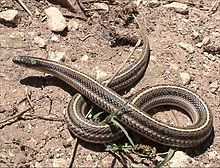Tropidoclonion
| Tropidoclonion | |
|---|---|
 | |
| Texas lined snake Tropidoclonion lineatum texanum | |
| Conservation status | |
| Scientific classification | |
| Kingdom: | Animalia |
| Phylum: | Chordata |
| Subphylum: | Vertebrata |
| Class: | Reptilia |
| Order: | Squamata |
| Suborder: | Serpentes |
| Family: | Colubridae |
| Subfamily: | Natricinae |
| Genus: | Tropidoclonion |
| Species: | T. lineatum |
| Binomial name | |
| Tropidoclonion lineatum (Hallowell, 1856) | |
| Synonyms | |
Tropidoclonion is a genus of small colubrid snakes, commonly known as lined snakes, which are endemic to North America. The single species in the genus, Tropidoclonion lineatum, has four subspecies.
Subspecies
- Tropidoclonion lineatum annectens Ramsey, 1953 - central lined snake
- Tropidoclonion lineatum lineatum (Hallowell, 1856) - northern lined snake
- Tropidoclonion lineatum mertensi H.M. Smith, 1965 - Mertens' lined snake
- Tropidoclonion lineatum texanum Ramsey, 1953 - Texas lined snake
Geographic range
Lined snakes are found throughout the central United States from Illinois to Texas. They prefer grassland areas with soft, moist soils.
Description
Lined snakes are olive green to brown with a distinctive tan or yellow stripe down the back from head to tail. They have similar stripes down each side on scale rows 2 and 3.[3] On the belly, they have a double row of clean-cut black half-moon spots running down the middle.[4] They have narrow heads and small eyes.
Adult size is typically less than 35 cm (14 inches) in total length. However, maximum recorded total length is 53 cm (21 in).[5]
The keeled dorsal scales are arranged in 19 rows at midbody. There are only 5 or 6 upper labials.[5]
Behavior
Lined snakes are semifossorial, spending most of their time hiding under rocks, leaf litter, logs, or buried in the soil. The majority of their diets consist of earthworms.
Reproduction
They are ovoviviparous, the young being born in August. The average brood is seven or eight.[6] The newborn juveniles are 10-12 cm (4-4¾ in.) long at birth.[4]
References
- ↑ 1.0 1.1 Stejneger, L., and T. Barbour 1917. A Check List of North American Amphibians and Reptiles. Harvard University Press. Cambridge, Massachusetts. 125 pp. (Tropidoclonion lineatum, pp. 99-100.)
- ↑ Boulenger, G.A. 1893. Catalogue of the Snakes in the British Museum (Natural History). Volume I., Containing the Families...Colubridæ Aglyphæ, part. Trustees of the British Museum (Natural History). (Taylor and Francis, Printers.) London. xiii + 448 pp. + Plates I.- XXVIII. (Ischnognathus lineatus, pp. 289-290.)
- ↑ Schmidt, K.P. and D.D. Davis. 1941. Field Book of Snakes of the United States and Canada. G.P. Putnam's Son's. New York. 365 pp. (Tropidoclonion lineatum, pp. 257-259, Figure 83 + Plate 29, Top, on p. 349.)
- ↑ 4.0 4.1 Conant, R. 1975. A Field Guide to Reptiles and Amphibians of Eastern and Central North America, Second Edition. Houghton Mifflin. Boston. xviii + 429 pp. ISBN 0-395-19979-4 (hardcover), ISBN 0-395-19977-8 (paperback). (Tropidoclonion lineatum, pp. 166-167 + Plate 24 + Map 123.)
- ↑ 5.0 5.1 Smith, H.M., and E.D. Brodie, Jr. 1982. Reptiles of North America: A Guide to Field Identification. Golden Press. New York. 240 pp. ISBN 0-307-13666-3 (paperback). (Tropidoclonion lineatum, pp. 152-153.)
- ↑ Force, E.R. 1931. Habits and Birth of the Lined Snake, Tropidoclonion lineatum (Hallowell). Copeia 1931: 51-53.
Further reading
- Conant, R., and W. Bridges. 1939. What Snake Is That? A Field Guide to the Snakes of the United States East of the Rocky Mountains. D. Appleton-Century. New York and London. Frontispiece map + viii + 163 pp. + Plates A-C, 1-32. (Tropidoclonion lineatum, pp. 114-115 + Plate 21, Figure 63.)
- Hallowell, E. 1856. Notice of a Collection of Reptiles from Kansas and Nebraska, presented to the Academy of Natural Sciences, by Dr. Hammond, U. S. A. Proc. Acad. Nat. Sci. Philadelphia 8: 238-253. (Genus Microps, p. 240; and species Microps lineatus, p. 241.)
- Stebbins, R.C. 2003. A Field Guide to Western Reptiles and Amphibians, Third Edition. The Peterson Field Guide Series. Houghton Mifflin. Boston and New York. xiii + 533 pp. ISBN 0-395-98272-3 (paperback). (Tropidoclonion lineatum, p. 391 + Plate 50 + Map 168.)
- Wright, A.H., and A.A. Wright. 1957. Handbook of Snakes of the United States and Canada. Comstock. Ithaca and London. 1,105 pp. (in 2 volumes) (Genus Tropidoclonion p. 879 + Figure 20, a-c, on p. 71; and species Tropidoclonion lineatum, pp. 879-884, Figure 252., Map 62.)
- Zim, H.S., and H.M. Smith. 1956. Reptiles and Amphibians: A Guide to Familiar American Species: A Golden Nature Guide. Simon and Schuster. New York. 160 pp. ("Lined Snake", pp. 106, 156.)
External links
| Wikimedia Commons has media related to Tropidoclonion lineatum. |
| Wikispecies has information related to: Tropidoclonion lineatum |
- Species Tropidoclonion lineatum at The Reptile Database
